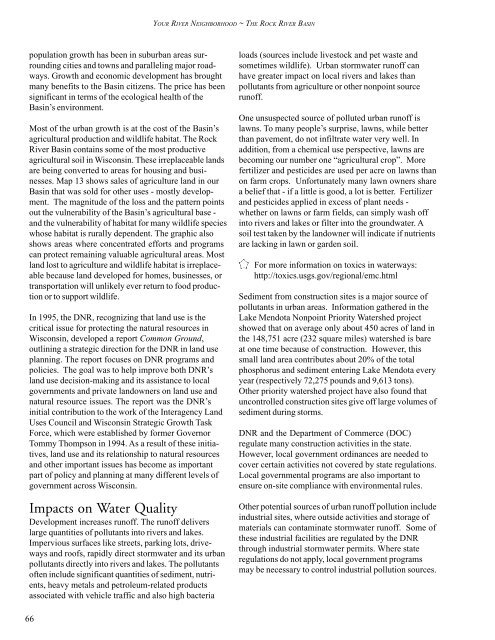Cities (PDF, 295KB) - Wisconsin Department of Natural Resources
Cities (PDF, 295KB) - Wisconsin Department of Natural Resources
Cities (PDF, 295KB) - Wisconsin Department of Natural Resources
You also want an ePaper? Increase the reach of your titles
YUMPU automatically turns print PDFs into web optimized ePapers that Google loves.
YOUR RIVER NEIGHBORHOOD ~ THE ROCK RIVER BASIN<br />
population growth has been in suburban areas surrounding<br />
cities and towns and paralleling major roadways.<br />
Growth and economic development has brought<br />
many benefits to the Basin citizens. The price has been<br />
significant in terms <strong>of</strong> the ecological health <strong>of</strong> the<br />
Basin’s environment.<br />
Most <strong>of</strong> the urban growth is at the cost <strong>of</strong> the Basin’s<br />
agricultural production and wildlife habitat. The Rock<br />
River Basin contains some <strong>of</strong> the most productive<br />
agricultural soil in <strong>Wisconsin</strong>. These irreplaceable lands<br />
are being converted to areas for housing and businesses.<br />
Map 13 shows sales <strong>of</strong> agriculture land in our<br />
Basin that was sold for other uses - mostly development.<br />
The magnitude <strong>of</strong> the loss and the pattern points<br />
out the vulnerability <strong>of</strong> the Basin’s agricultural base -<br />
and the vulnerability <strong>of</strong> habitat for many wildlife species<br />
whose habitat is rurally dependent. The graphic also<br />
shows areas where concentrated efforts and programs<br />
can protect remaining valuable agricultural areas. Most<br />
land lost to agriculture and wildlife habitat is irreplaceable<br />
because land developed for homes, businesses, or<br />
transportation will unlikely ever return to food production<br />
or to support wildlife.<br />
In 1995, the DNR, recognizing that land use is the<br />
critical issue for protecting the natural resources in<br />
<strong>Wisconsin</strong>, developed a report Common Ground,<br />
outlining a strategic direction for the DNR in land use<br />
planning. The report focuses on DNR programs and<br />
policies. The goal was to help improve both DNR’s<br />
land use decision-making and its assistance to local<br />
governments and private landowners on land use and<br />
natural resource issues. The report was the DNR’s<br />
initial contribution to the work <strong>of</strong> the Interagency Land<br />
Uses Council and <strong>Wisconsin</strong> Strategic Growth Task<br />
Force, which were established by former Governor<br />
Tommy Thompson in 1994. As a result <strong>of</strong> these initiatives,<br />
land use and its relationship to natural resources<br />
and other important issues has become as important<br />
part <strong>of</strong> policy and planning at many different levels <strong>of</strong><br />
government across <strong>Wisconsin</strong>.<br />
Impacts on Water Quality<br />
Development increases run<strong>of</strong>f. The run<strong>of</strong>f delivers<br />
large quantities <strong>of</strong> pollutants into rivers and lakes.<br />
Impervious surfaces like streets, parking lots, driveways<br />
and ro<strong>of</strong>s, rapidly direct stormwater and its urban<br />
pollutants directly into rivers and lakes. The pollutants<br />
<strong>of</strong>ten include significant quantities <strong>of</strong> sediment, nutrients,<br />
heavy metals and petroleum-related products<br />
associated with vehicle traffic and also high bacteria<br />
loads (sources include livestock and pet waste and<br />
sometimes wildlife). Urban stormwater run<strong>of</strong>f can<br />
have greater impact on local rivers and lakes than<br />
pollutants from agriculture or other nonpoint source<br />
run<strong>of</strong>f.<br />
One unsuspected source <strong>of</strong> polluted urban run<strong>of</strong>f is<br />
lawns. To many people’s surprise, lawns, while better<br />
than pavement, do not infiltrate water very well. In<br />
addition, from a chemical use perspective, lawns are<br />
becoming our number one “agricultural crop”. More<br />
fertilizer and pesticides are used per acre on lawns than<br />
on farm crops. Unfortunately many lawn owners share<br />
a belief that - if a little is good, a lot is better. Fertilizer<br />
and pesticides applied in excess <strong>of</strong> plant needs -<br />
whether on lawns or farm fields, can simply wash <strong>of</strong>f<br />
into rivers and lakes or filter into the groundwater. A<br />
soil test taken by the landowner will indicate if nutrients<br />
are lacking in lawn or garden soil.<br />
For more information on toxics in waterways:<br />
http://toxics.usgs.gov/regional/emc.html<br />
Sediment from construction sites is a major source <strong>of</strong><br />
pollutants in urban areas. Information gathered in the<br />
Lake Mendota Nonpoint Priority Watershed project<br />
showed that on average only about 450 acres <strong>of</strong> land in<br />
the 148,751 acre (232 square miles) watershed is bare<br />
at one time because <strong>of</strong> construction. However, this<br />
small land area contributes about 20% <strong>of</strong> the total<br />
phosphorus and sediment entering Lake Mendota every<br />
year (respectively 72,275 pounds and 9,613 tons).<br />
Other priority watershed project have also found that<br />
uncontrolled construction sites give <strong>of</strong>f large volumes <strong>of</strong><br />
sediment during storms.<br />
DNR and the <strong>Department</strong> <strong>of</strong> Commerce (DOC)<br />
regulate many construction activities in the state.<br />
However, local government ordinances are needed to<br />
cover certain activities not covered by state regulations.<br />
Local governmental programs are also important to<br />
ensure on-site compliance with environmental rules.<br />
Other potential sources <strong>of</strong> urban run<strong>of</strong>f pollution include<br />
industrial sites, where outside activities and storage <strong>of</strong><br />
materials can contaminate stormwater run<strong>of</strong>f. Some <strong>of</strong><br />
these industrial facilities are regulated by the DNR<br />
through industrial stormwater permits. Where state<br />
regulations do not apply, local government programs<br />
may be necessary to control industrial pollution sources.<br />
66



![Nature program winter schedule [PDF] - Wisconsin DNR](https://img.yumpu.com/22471254/1/190x245/nature-program-winter-schedule-pdf-wisconsin-dnr.jpg?quality=85)
![City of Middleton [PDF] - Wisconsin Department of Natural Resources](https://img.yumpu.com/22300392/1/190x245/city-of-middleton-pdf-wisconsin-department-of-natural-resources.jpg?quality=85)

![Wetland Conservation Activities [PDF] - Wisconsin Department of ...](https://img.yumpu.com/21975633/1/190x245/wetland-conservation-activities-pdf-wisconsin-department-of-.jpg?quality=85)




![Baraboo River Region[PDF] - Wisconsin Department of Natural ...](https://img.yumpu.com/21975619/1/190x245/baraboo-river-regionpdf-wisconsin-department-of-natural-.jpg?quality=85)




